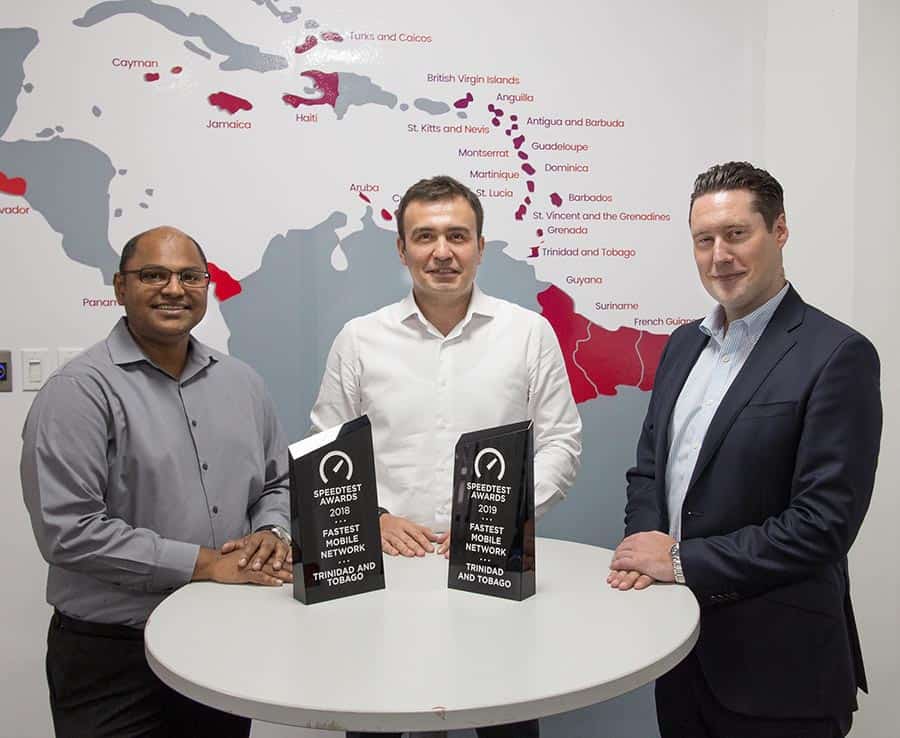
Above: Chandrika Samaroo, Jabbor Kayumov and Liam Donelly at DigicelTT’s St Clair Office. Photo by Mark Lyndersay.
Originally published in Newsday’s BusinessDay for December 12, 2019
“I was disappointed with the product I saw launched,” DigicelTT’s CEO Jabbor Kayumov said.
Kayumov had convened a meeting on Tuesday with Newsday, Technical Director Chandrika Samaroo and Business Services Manager Liam Donnelly to talk 5G and Digicel’s position on last week’s announcement of a service using the specification by telecommunications rival TSTT.
Some of the conversation was an extension of the trash-talking both companies had been indulging in over the last few weeks, after Digicel’s CEO dismissed the pending 5G announcement as technology for which the market wasn’t ready
That prompted a bristly response from TSTT CEO Ronald Walcott who said that “TSTT is ready to give the nation 5G.”
On Tuesday, Kayumov described the launch as “a shot without the bullet.”
“The (5G) solution wasn’t addressing customer needs as I understand it,” he said.
“We didn’t launch LTE first, but we are the fastest and the biggest, we have coverage across the country. We have the (Ookla Speedtest) award to prove it.”
“We don’t want to manipulate customer perception with tricks of marketing.”
“My customer needs to make a video call with good quality on mobile.”
“At home, we will give them HD quality using the fiber network. I expected the competition to trigger me to do something, but I think we still have a way to go.”
Kayumov believes that a stable 10 megabit connection is the most important selling point for his customer base and has focused his company on delivering that.
“We have to get the best out of the mobile network without having people suffer from bill shock. We are consistently trying to find the right mix for customers so that they are comfortable with using broadband.”
The current strategy is to install AWS capable transmitters in the most congested zones.
“Ten megabits is the goal, but we are currently experiencing eight to nine,” Samaroo said.
“To achieve the goal, I’ll need to build a lot more sites.”
The company announced plans in November to do exactly that.
“TATT did a great job. This is one of the more operational regulators I’ve ever worked with.”
– Jabbor Kayumov
“Half of the population of TT is still carrying 3G phones, and some are still using 2G,” Kayumov said.
“There is still a big segment of customers who are still content with voice.”
“As soon as any area is becoming congested, I will upgrade them to AWS.”
Kayumov is particularly pleased with the response of the Telecommunications Authority (TATT) to the increasing requirements for broadcast spectrum that the new technologies are demanding.
“TATT did a great job,” he said.
“This is one of the more operational regulators I’ve ever worked with. They came back to us with AWS (the Advanced Wireless Services carrier band), which will serve our customers for the next 12 to 24 months.”
Digicel is also building more control over their accounts into its My Digicel App. Kayumov demonstrated new features on the app that allows the company’s customers to download a history of bills and will introduce a new transaction monitoring feature soon.
“I have my team working hard. Customers will be able to see all their transactions on the network down to the penny,” he promised.
When the feature is implemented, customer use and cost on the voice network will be available in real time with data use updated within a few hours.
“We are definitely not going to follow the TSTT 5G solutions,” Kayumov said.
“We are going to pursue solutions that meet customer needs.”
The Fibre alternative
“Any mobile operator would be insane to say that 5G is not on their roadmap,” said Chandrika Samaroo, Technical Director of DigicelTT.
“We will invest when we get the right spectrum at the right price.”
For 5G mobile implementation, Samaroo explained, 2,500 to 3500 MHZ is becoming a global standard.
“We need 100 MHZ (within the spectrum) to be able to give people the kind of leap in speeds that would be a generational leap.”
Describing fiber as the best possible connection medium, Samaroo called it “a virtually limitless medium.”
“You can change your equipment, and you can improve the service.”
The company has invested heavily in building out a fiber network across Trinidad and particularly in Tobago, in a “customer-centric network development strategy.”
“When it comes to fixed broadband, what can be better than fiber?” Kayumov asked rhetorically.
“My last mile is fiber to the home and business.”



This is great, Digicel is investing hard in Trinidad and Tobago. But neglecting Jamaica, Digicel Jamaica service is terrible in Jamaica. Not to mention they have not rolled out Digicel play fibre optic service beyond limit areas in Kingston and St Andrew, Portmore and Spanish Town. Not even Montego Bay has Digicel play. But I get to understand that all or most of Trinidad and Tobago has Digicel fibre service. I’m disappointed significantly with Digicel, they treat Jamaica like shit. Not to mention they did criminal actions to force Caricel and Xtrinet out of the Jamaican market.